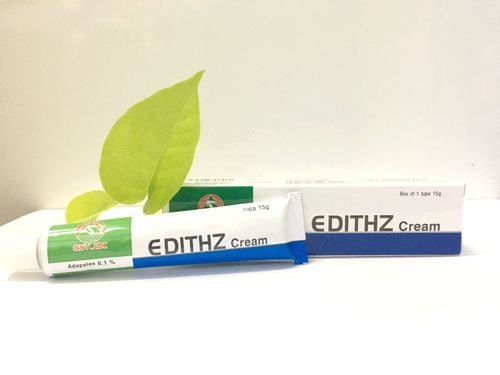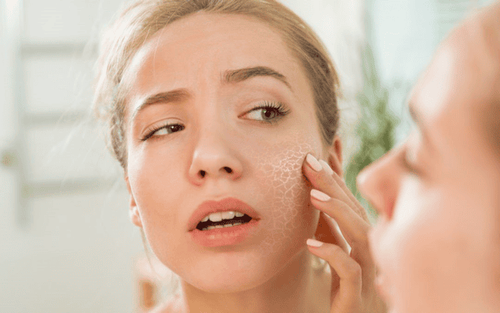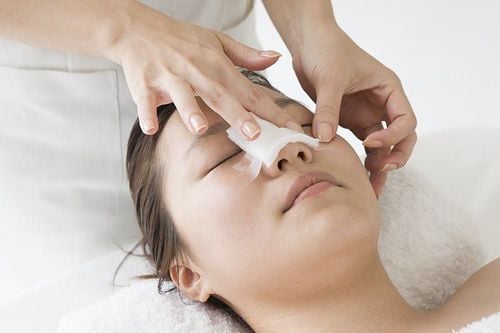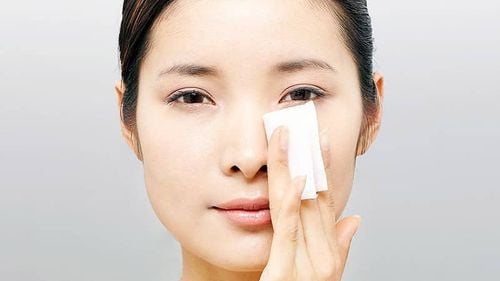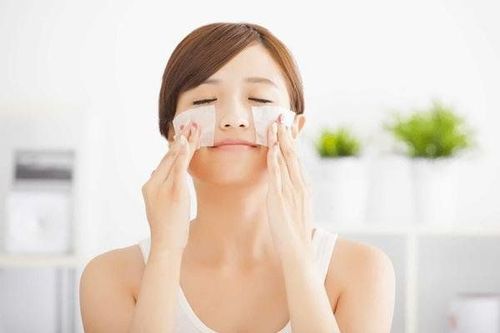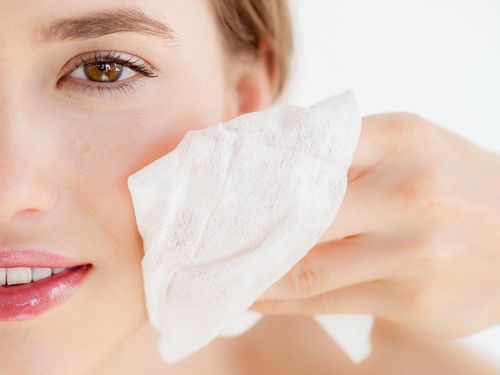This is an automatically translated article.
Proper skin care means finding the right skin care for your skin type. But what if you have combination skin? In other words, you have to find the right care plan for both oily and dry skin. Here are some tips to keep your skin healthy.
1. What factors create combination skin?
While taking care of combination skin isn't always the easiest, you can still find a routine that helps combat dry patches and create a shine.
If your skin's oiliness is not in the usual T-zone and if your skin is dry in other areas or if you have other problems like pimples and larger pores. Don't worry, there's a solution no matter what your combination skin looks like.
Dr. Joshua Zeichner, director of cosmetic and clinical research in New York, says, “Genetics are what determines your skin type. And we can't actively change our skin type, says Tanya Kormeili, a dermatologist in Santa Monica, California. But the aging process and hormonal fluctuations can cause skin changes. Your skin will often become drier and less oily as you age. Other factors such as hormones, menstrual conditions and the use of birth control pills can also affect the skin. Your current diet, weather, and skin care routine also significantly affect your skin.
2. Are there different types?
There is no one formula that works for all combination skin types, as everyone's combination skin types are different. However, combination skin usually refers to oily shine in the T-zone and dryness on the cheeks. Skin has a shiny appearance as a result of a high concentration of oil glands. Therefore, you need to pay attention to your skin to determine its needs. Signs of oily skin include shiny skin, larger pores, blackheads, and whiteheads. Signs of dry skin include flaking, red skin, and roughness to the touch.
Combination skin can also be very sensitive and may develop burning, stinging or other reactions when trying to use skin care products. Combination skin does not mean that your face will be 50% oily and 50% dry as some people will have more oily areas than dry areas and vice versa.

Sự khác nhau giữa các loại da
3. Are there any general guidelines?
When it comes to skin care, it's important to remember your skin is unique and what works for someone else may not work for you and this is especially true when it comes to combination skin. This is one of the hardest skin types to care for as different parts of the face tend to require different techniques and here are a few suggestions to get you started.
3.1. Divide and conquer
It will be a bit difficult because you cannot take care of your entire face in one go. You should carefully study and divide your face into different skin zones (oily, dry, etc.) and treat each type accordingly.
3.2. Reverses oil production and intervenes for oily areas
To reduce excess oil production, you'll want to use skin care products that absorb oil and soften the skin, but these types of products can also irritate any dry skin, as so make sure you apply the exact areas of your skin that are oily and dab them on where they need to be, rather than all over your face.
3.3. Improves and softens skin for dry areas
Similar to oily areas, you will only apply moisturizers to dry areas because if they come into contact with oily patches they can make them greasy.

Thoa sản phẩm dưỡng ẩm vào vùng da khô
3.4. Don't be afraid to mix and match
You should evaluate your skin daily and change your routine for proper skin care. For example, if you are going through an irritated day, cut back on your dry skin care. and apply more moisturizer. You can also use certain treatments only once a week, or alternate between different types of products.
3.5. Know when to follow sequence and when to skip
When using foundation products, the general idea is to start with thinner water-based formulations before moving on to thicker oil-based ones. However, certain areas of your face may not be suitable or even necessary for this sequence.
Some ingredients such as alpha hydroxy acids and beta hydroxy acids can benefit the entire face. However, the oily parts of your face will benefit from a gentler strategy and for sensitive skin you should apply as little as possible.
3.6. Avoid products with excessive fragrance or other irritants
Any product that includes ingredients like fragrance or alcohol can be irritating to both dry and oily skin. They can cause dry areas to become drier, while oily areas can produce more oil and potentially lead to breakouts.
3.7. Choose hypoallergenic products
You need to choose and make sure that your cosmetics are non-irritating and make sure they are not likely to clog your pores.
To avoid aggravating oily and acne-prone skin, try using hypoallergenic lotions and creams. But do not completely trust the words on the product label.
You should check the ingredient list to find out which substances can cause allergy problems. Some are safe like isopropyl myristate and lanolins, helpful supplements, hemp seeds, and sunflower oil.
3.8. Provide enough water
In addition to applying moisturizers to your skin, it's also important to make sure you drink enough water each day. Hydration can help prevent dry, flaky skin and prevent excess oil production.
Although there is still a question mark surrounding the link between water intake and hydrated skin, you should drink at least eight glasses of water a day.

Nên uống đủ 1500ml đến 2000ml nước mỗi ngày
4. What does an acne skin care routine look like?
When you find a new skin care regimen, take it step by step. Prioritize choosing mild products to help moisturize dry areas but not make them oily. And when your skin has specific problems, you only need to apply the treatment to the areas that need it.
Ingredients to look for include: Hyaluronic acid is ideal for the entire face, it hydrates skin without creating a greasiness that can aggravate pre-existing oiliness. Try Regular Hyaluronic Acid Essence 2% + B5 or CeraVe Hyaluronic Acid Serum. Salicylic acid is a substance that can regulate oil production and unclog pores. Lactic acid is a gentle exfoliator that can gently remove dead skin cells from dry areas and unclog pores. Emollients range from butters like shea to oils like coconut. They soften and smooth dry skin by repairing scaly cells. Antioxidants work to protect your skin from environmental damage such as ultraviolet rays. You should choose products with vitamin C to maintain general skin health and provide anti-inflammatory effects. You should also choose products with vitamin E to moisturize and heal the wound. Morning: Cleanser: Use this important product in the morning to help remove dirt and sweat that has built up overnight. Toner: Removes any oils that your cleanser has missed and balances the skin's pH. You should skip alcohol-based toners in favor of gentle serum or treatment formulas: These are products that focus on hydrating and protecting your skin in the morning. Moisturizer: You should have two different moisturizers to hydrate and nourish different parts of your face. The creamy formula is ideal for dry areas. For those with oily skin, try a lightweight water-based product, like Simple Water Boost Hydrating Gel Cream. Sunscreen: This helps clear skin and protect from UV damage, but you have to be sure to choose the right product to use. Makeup (if desired): If you want to wear makeup, choose light products to create a base. For concealers, look for oil-free, hypoallergenic formulas. Evening: Remove makeup (if needed): Once you've applied makeup, you need to remove it afterward to keep your pores clear and allow your skin to breathe. Cleanser: A good nighttime cleanser will remove any stubborn remnants of day makeup and dirt, help fight congestion, and soothe dry skin. Serum or moisturizer: Evening is the perfect time for stronger moisturizers. Choose an emollient-rich moisturizer for dry patches, a restorative vitamin C product, or even a harmless retinol treatment to improve skin texture. The Essential Exfoliator: Exfoliation is a very important step to unclog pores and reduce dryness. Use a gentle chemical exfoliant and apply it at least once a week or up to two or three times a week if needed. Mask: Use a mask that is made for combination skin instead of applying one mask all over your face. Try a clay mask for oil control and a moisturizing mask for dry spots. If your over-the-counter skin care products aren't meeting the goals you're looking for, make an appointment with your dermatologist for expert help. You should also see a dermatologist if you're having trouble controlling your skin like acne. The dermatologist will examine the skin closely, magnifying and magnifying certain areas and gently touching them to see how they feel.
Clinical Dermatology Specialist Vinmec International General Hospital undertakes diagnosis, treatment, prevention and rehabilitation of diseases in the specialty of Leprosy and Dermatology. With a team of leading medical doctors, the system With a system of modern technological equipment, the hospital provides comprehensive and professional medical examination, consultation and treatment services; civilized, polite, safe and sterile medical examination and treatment space.
Please dial HOTLINE for more information or register for an appointment HERE. Download MyVinmec app to make appointments faster and to manage your bookings easily.
Reference source: healthline.com




